Deconstructing voltage sensor function and pharmacology in sodium channels
- PMID: 19005548
- PMCID: PMC2587061
- DOI: 10.1038/nature07473
Deconstructing voltage sensor function and pharmacology in sodium channels
Abstract
Voltage-activated sodium (Na(v)) channels are crucial for the generation and propagation of nerve impulses, and as such are widely targeted by toxins and drugs. The four voltage sensors in Na(v) channels have distinct amino acid sequences, raising fundamental questions about their relative contributions to the function and pharmacology of the channel. Here we use four-fold symmetric voltage-activated potassium (K(v)) channels as reporters to examine the contributions of individual S3b-S4 paddle motifs within Na(v) channel voltage sensors to the kinetics of voltage sensor activation and to forming toxin receptors. Our results uncover binding sites for toxins from tarantula and scorpion venom on each of the four paddle motifs in Na(v) channels, and reveal how paddle-specific interactions can be used to reshape Na(v) channel activity. One paddle motif is unique in that it slows voltage sensor activation, and toxins selectively targeting this motif impede Na(v) channel inactivation. This reporter approach and the principles that emerge will be useful in developing new drugs for treating pain and Na(v) channelopathies.
Figures
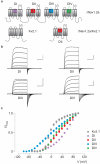
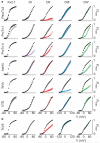
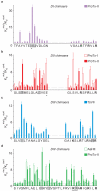
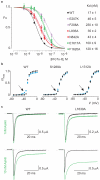
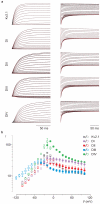
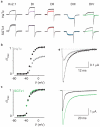
Comment in
-
Ion channels: The voltage-sensor quartet.Nature. 2008 Nov 13;456(7219):183-5. doi: 10.1038/456183a. Nature. 2008. PMID: 19005542 Free PMC article.
Similar articles
-
Portability of paddle motif function and pharmacology in voltage sensors.Nature. 2007 Nov 15;450(7168):370-5. doi: 10.1038/nature06266. Nature. 2007. PMID: 18004375 Free PMC article.
-
Molecular Interactions between Tarantula Toxins and Low-Voltage-Activated Calcium Channels.Sci Rep. 2016 Apr 5;6:23894. doi: 10.1038/srep23894. Sci Rep. 2016. PMID: 27045173 Free PMC article.
-
Inhibition of sodium channel gating by trapping the domain II voltage sensor with protoxin II.Mol Pharmacol. 2008 Mar;73(3):1020-8. doi: 10.1124/mol.107.041046. Epub 2007 Dec 21. Mol Pharmacol. 2008. PMID: 18156314
-
Site-3 toxins and cardiac sodium channels.Toxicon. 2007 Feb;49(2):181-93. doi: 10.1016/j.toxicon.2006.09.017. Epub 2006 Sep 27. Toxicon. 2007. PMID: 17092528 Free PMC article. Review.
-
Insect-selective spider toxins targeting voltage-gated sodium channels.Toxicon. 2007 Mar 15;49(4):490-512. doi: 10.1016/j.toxicon.2006.11.027. Epub 2006 Dec 5. Toxicon. 2007. PMID: 17223149 Review.
Cited by
-
Sodium channel blockers for the treatment of neuropathic pain.Neurotherapeutics. 2009 Oct;6(4):663-78. doi: 10.1016/j.nurt.2009.08.001. Neurotherapeutics. 2009. PMID: 19789071 Free PMC article. Review.
-
Insensitivity to pain induced by a potent selective closed-state Nav1.7 inhibitor.Sci Rep. 2017 Jan 3;7:39662. doi: 10.1038/srep39662. Sci Rep. 2017. PMID: 28045073 Free PMC article.
-
Spider Venom Peptide Pn3a Inhibition of Primary Afferent High Voltage-Activated Calcium Channels.Front Pharmacol. 2021 Jan 28;11:633679. doi: 10.3389/fphar.2020.633679. eCollection 2020. Front Pharmacol. 2021. PMID: 33584315 Free PMC article.
-
ω-Grammotoxin-SIA inhibits voltage-gated Na+ channel currents.J Gen Physiol. 2024 Oct 7;156(10):e202413563. doi: 10.1085/jgp.202413563. Epub 2024 Jul 23. J Gen Physiol. 2024. PMID: 39042091 Free PMC article.
-
Voltage-Sensing Domain of the Third Repeat of Human Skeletal Muscle NaV1.4 Channel As a New Target for Spider Gating Modifier Toxins.Acta Naturae. 2021 Jan-Mar;13(1):134-139. doi: 10.32607/actanaturae.11279. Acta Naturae. 2021. PMID: 33959393 Free PMC article.
References
-
- Frech GC, VanDongen AM, Schuster G, Brown AM, Joho RH. A novel potassium channel with delayed rectifier properties isolated from rat brain by expression cloning. Nature. 1989;340:642–5. - PubMed
-
- Tempel BL, Papazian DM, Schwarz TL, Jan YN, Jan LY. Sequence of a probable potassium channel component encoded at Shaker locus of Drosophila. Science. 1987;237:770–5. - PubMed
-
- Auld VJ, et al. A rat brain Na+ channel alpha subunit with novel gating properties. Neuron. 1988;1:449–61. - PubMed
-
- Trimmer JS, et al. Primary structure and functional expression of a mammalian skeletal muscle sodium channel. Neuron. 1989;3:33–49. - PubMed
Publication types
MeSH terms
Substances
Grants and funding
LinkOut - more resources
Full Text Sources
Other Literature Sources

